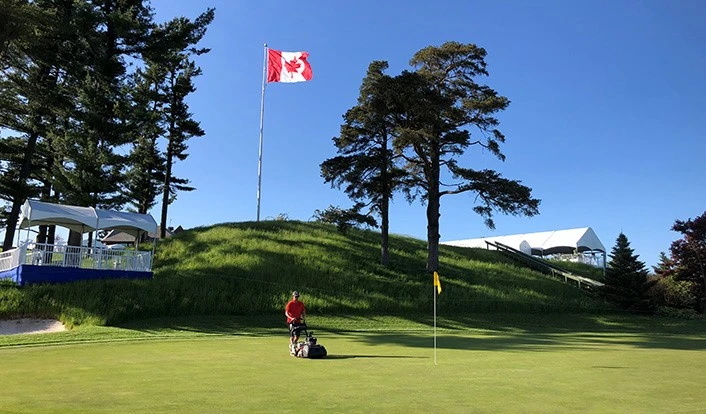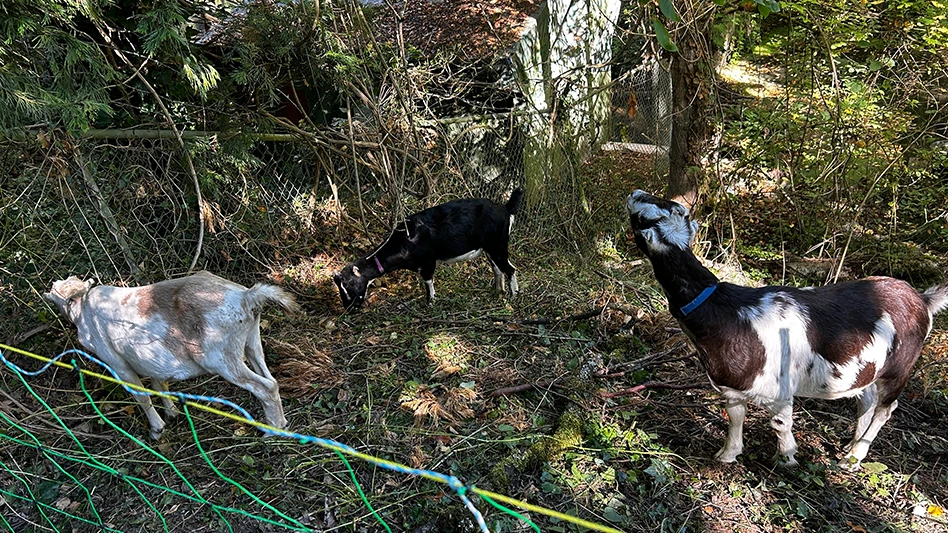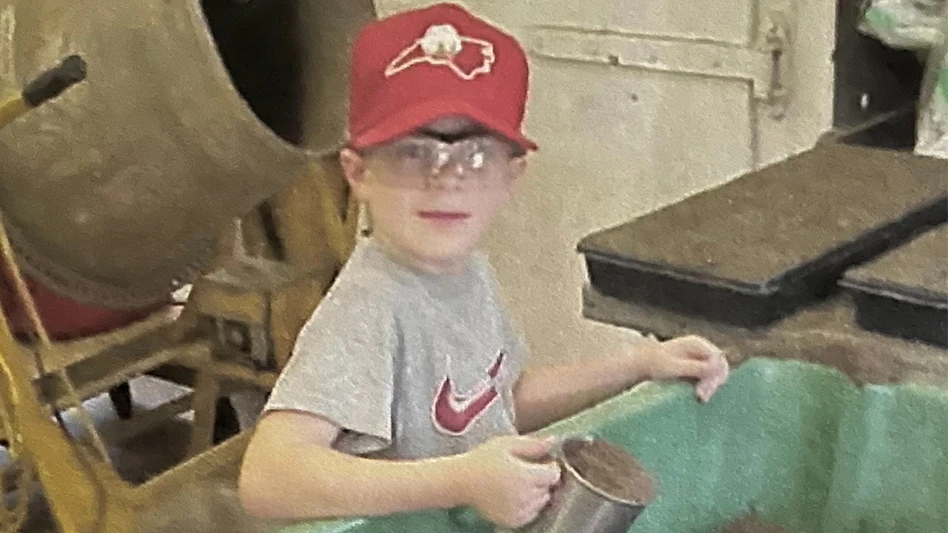
Guy Cipriano
A national open, especially one contested in a country with a proportionally low number of worldwide televised golf showcases, presents reoccurring moments for celebration.
On a Monday that methodically shifted from frigid – even by June in Ontario standards – to fantastic, the Hamilton Golf & Country Club turf team and volunteers mingle around the maintenance facility. The first of two pro-ams scheduled for RBC Canadian Open week becomes a slog, delaying the start of an evening maintenance shift.
Nobody seems bothered six-hour rounds are prolonging the day. Perhaps, after starting work 13 hours earlier in 37-degree weather, evening temperatures approaching 70 degrees yield cheer. Or, more likely, sharing a major moment with a friend, mentor, cousin, neighbor, parent, child or sibling must be savored regardless of unexplainable waits.
So, instead of moping, a half-dozen youthful females and males gather around a picnic table and play a version of “Cotton-Eyed Joe” recorded in 1994. As they sing and dance, a co-worker who started fixing turf equipment before the song was released discusses his personal evolution and how the 2019 Canadian Open contrasts other televised tournaments at Hamilton. The first professional tournament of Wayne Shaw’s career, the 1996 du Maurier Seniors, included an infamous personal moment: somebody stole his truck.
Shaw borrowed his sister-in-law’s truck and made it to the course. The truck was later found and Shaw, the club’s mechanic, tells the story nonchalantly after the music stops. The festive banter moves to a paved area outside the maintenance facility Shaw has called his office since 1986. Once assistant superintendent Tracy Fowler, a colleague with a similarly lengthy tenure, sounds a horn signifying the start of the evening shift, Shaw roams an enchanting course, checking the operational quality of an equipment fleet that has morphed over the last 33 years. “You look around here,” he says. “You see how much stuff we have. We have 10 tractors. We had two when I started here.”
The Canadian Open also has morphed. Harry Colt designed 27 holes when the club relocated to Ancaster, a stately community seven miles from the city of Hamilton’s industrial center. The South and West nines support tournament play. Later in the week, the singing and dancing reaches the first hole of the East nine, site of a Friday night concert slightly bigger than maintenance facility singalongs: a performance by popular country duo Florida Georgia Line.
Golf Canada officials reported around 120,000 fans entered the Hamilton grounds June 3-9 and beer sales increased 65 percent over the 2018 tournament at Glen Abbey Golf Club in suburban Toronto. The golf headliner, Northern Irishman Rory McIlroy, smashed the field to capture his 16th PGA Tour title. The tournament marked the 100th anniversary of the first of six Canadian Opens at Hamilton and the final major event contested on the current version of the course. An aggressive 27-hole project led by Colt savant Martin Ebert commences later this year.
A Monday evening spent observing the scene and meeting the people responsible for maintaining Hamilton negates any hyperbole when people of the host country refer to the Canadian Open as a “major.” Canadians are golf enthusiasts. Nearly one in six plays golf, according to a 2017 report released by Golf Canada, The PGA of Canada and National Golf Foundation. Canada’s participation rate is double the rate of its southern neighbor.
Canada has 2,298 golf facilities, according to the same report, with nearly a third of the supply (682 courses) located in Ontario. “We are one of the bigger hubs of golf courses,” says Hamilton superintendent Rhod Trainor, who will retire this year after a successful 30-year-run at the admired club. “We compare ourselves to Chicago and some of those American hotbeds.”
Despite the golf fervor and abundance of quality facilities, only one Canadian course receives the annual honor of hosting a PGA Tour tournament. By comparison, the 2018-19 PGA Tour schedule includes 37 American venues. Golf Canada rotates Canadian Open sites, although Glen Abbey hosted the tournament 30 times from 1977 to 2018. Trainor attended his first Canadian Open in the 1990s at Glen Abbey, where his best friend Dean Baker served as superintendent. “Canada has the Toronto Blue Jays and they might as well be the Canadian Blue Jays,” says Trainor, referring to the country’s lone Major League Baseball franchise. “This is the only PGA Tour tournament in Canada. Whether you live in Ontario or British Columbia or Nova Scotia, this is the one you’re most interested in.”
Bonds within the Hamilton crew and Canadian turf community run deep. Chris Wallace, a 22-year Hamilton veteran and Shaw’s second cousin, met Trainor through curling, one of Canada’s winter pastimes. He spent his first three Canadian Opens leading a crew responsible for maintaining Hamilton’s nearly 90 bunkers to PGA Tour specifications. A sore back means he’s sitting on a fairway mower while waiting for the Monday evening maintenance shift to begin. “This Canadian Open is big,” he says. “I don’t know how big, but it’s like waiting for a bomb to go off. You can tell it’s bigger than the other ones.”
Scott Borer, a longtime curling friend of Trainor, is an electric lineman who used a vacation week to work split golf course maintenance shifts. Borer also volunteered the 2003, ’06 and ’12 Canadian Opens at Hamilton. “I’m a lineman by trade, but golf is my passion,” he says. “Even though I take vacation to come here and don’t get paid, I wouldn’t want it any other way. I love being here for the week.”
Borer’s fourth Canadian Open carried special meaning because his 16-year-old son Noah works at Hamilton. Borer dropped Noah off at school following morning shifts and the duo enthusiastically returned to the course each afternoon. Employees with the same last name are part of Hamilton’s charm. “This industry is a brotherhood and sisterhood all the way down to the people who work here,” associate superintendent Jordan Kitchen says.
Tracy Fowler and her brother, Jamie, the club’s arborist, demonstrate the familial ties. Tracy has worked at the club for 33 years, three years longer than Jamie, who briefly left golf course maintenance to pursue a welding career. “It was a horrible environment,” he says. “You’re breathing in smoke all the time. This course is our office. This course is our factory.”
The course also feels like home. Tracy and Jamie’s father, Tom, worked 47 years at the club, ascending from crew member to mechanic. Tom retired three years ago, but still asks his children about the club and its people.
Tracy and Jamie started working at Hamilton, where their uncle Bill Thompson held a supervisory position, before they could drive. Uncle Bill handed Tracy a garbage can and she weeded bunkers on her first day of work; Jamie was handed a trimmer and gas can and told to tidy the areas surrounding Ancaster Creek. “We grew up on a farm, so we were used to being outside,” Tracy says. “We loved being outside. The job just worked for us.”
Following high school, Tracy explored multiple career routes. She earned a horticulture degree from the University of Guelph and Trainor offered her an assistant superintendent position. A childhood job turned into a career. “I didn’t think it would last this long,” she says. “But I was like, ‘I don’t want to move, I don’t want to commute, and I like it here.’ One year led into another year, and the next thing you know, I have been here for 33 years.”
Without their current jobs, Tracy, who has 6-year-old twins, and Jamie are unsure how much time they would spend together, because they live busy adult lives. Remaining at Hamilton has allowed them to share four Canadian Opens. “I just want people to see how beautiful this place is,” says Jamie, whose tree clearing efforts opened enthralling views of valleys and mounds Colt utilized in the early 1900s.
Hamilton’s other sister-brother duo, Kayla and Clayton Campbell, worked their first Canadian Open together last month. Kayla, a former early childhood education student determined to pursue a career in golf course maintenance, excitedly bounced between holes, mowing greens for golf stars, including 26 participants from her home country. “This is my first Canadian Open and I’m very excited,” she says before the Monday evening shift. “The energy is very high with me. I’m an energetic person anyways. I’m very proud of mowing those greens.”
Clayton, a technician in his 10th season at Hamilton, exudes similar energy and pride, especially when observing his sister’s zest for golf course maintenance. Kayla approached Clayton a few years ago about working at the course. Neither imagined the conversation would lead to a third Campbell pursuing a full-time turf career. Their older brother, Ryan is an assistant superintendent at Beach Grove Golf & Country Club in Windsor.
The Campbells are philosophical about the Canadian Open and its impact on their family. Anything providing glimpses into the Hamilton region’s changing demographics – Canada’s ninth-largest city possesses an industrial reputation – to a wide audience must be embraced, thus the greens Kayla mows and Clayton treats represent something greater than immaculate Poa annua.
“It’s like the Raptors being in the NBA Finals,” Clayton says. “It allows people to see what Canada is about. We’re not showshoes and all those stereotypical things.” Kayla interrupts to emphasize the irony in her brother’s statement. “We were in scarves this morning!” she says. Clayton chuckles and adds, “Americans have a sense of pride in America. Canadians have that same sense of pride. Allowing the world to see anything in this country means something to us.”
Kayla plans on obtaining a turf managers’ short course certificate through Guelph, where Trainor, Kitchen and Tracy obtained their formal turfgrass education. The managerial trio provides guidance on apprenticeship and job training programs to young employees considering golf course maintenance careers. “Our strength is our people,” Kitchen says. “We have been a great incubator for some great turf professionals. We want to be a launching pad for careers.”
The camaraderie, career boost and festive atmosphere turf professionals experienced last month will be duplicated when the Canadian Open returns to Hamilton in 2023. The PGA Tour’s decision to move the Canadian Open from the July week following the British Open to the June week before the U.S. Open attracted a marketable 2019 field. A side benefit of the move is enhanced turf quality. “Early June is typically our best conditions,” Trainor says. Fan friendly additions such as the weekend concerts and a raucous hockey-themed par-3 called “The Rink” further contribute to the momentum.
Unless the Raptors become an NBA Finals regular, one of Canada’s seven NHL teams experiences a revitalization or the Canadian Football League’s appeal extends across borders, there’s no other major reoccurring major summer sporting event in a nation of 37 million proud and active residents. The opportunity to prepare surfaces for the celebration will always be worth the wait.
Guy Cipriano is GCI's editor.
About this series
Our Major is a three-part series exploring turf teams preparing for big moments. Subscribe to Golf Course Industry’s enewsletters for digital exclusives about the events profiled by entering http://bit.ly/GCIenewsletters into your web browser. Part 2 will profile the people and pride associated with the Sparrows Point (Md.) Country Club member-guest.
Latest from Golf Course Industry
- Albaugh receives registration for chlorantraniliprole
- Honored by the association he helped expand
- The Carolinas GCSA Conference and Show: 5 W’s preview
- A great game. A sustainable game
- Envu welcomes new campaign activation manager
- Beyond the Page 61: An apprenticeship roundtable
- Epoch Science introduces Plant Fitness turf product line
- Pennsylvania preservation





